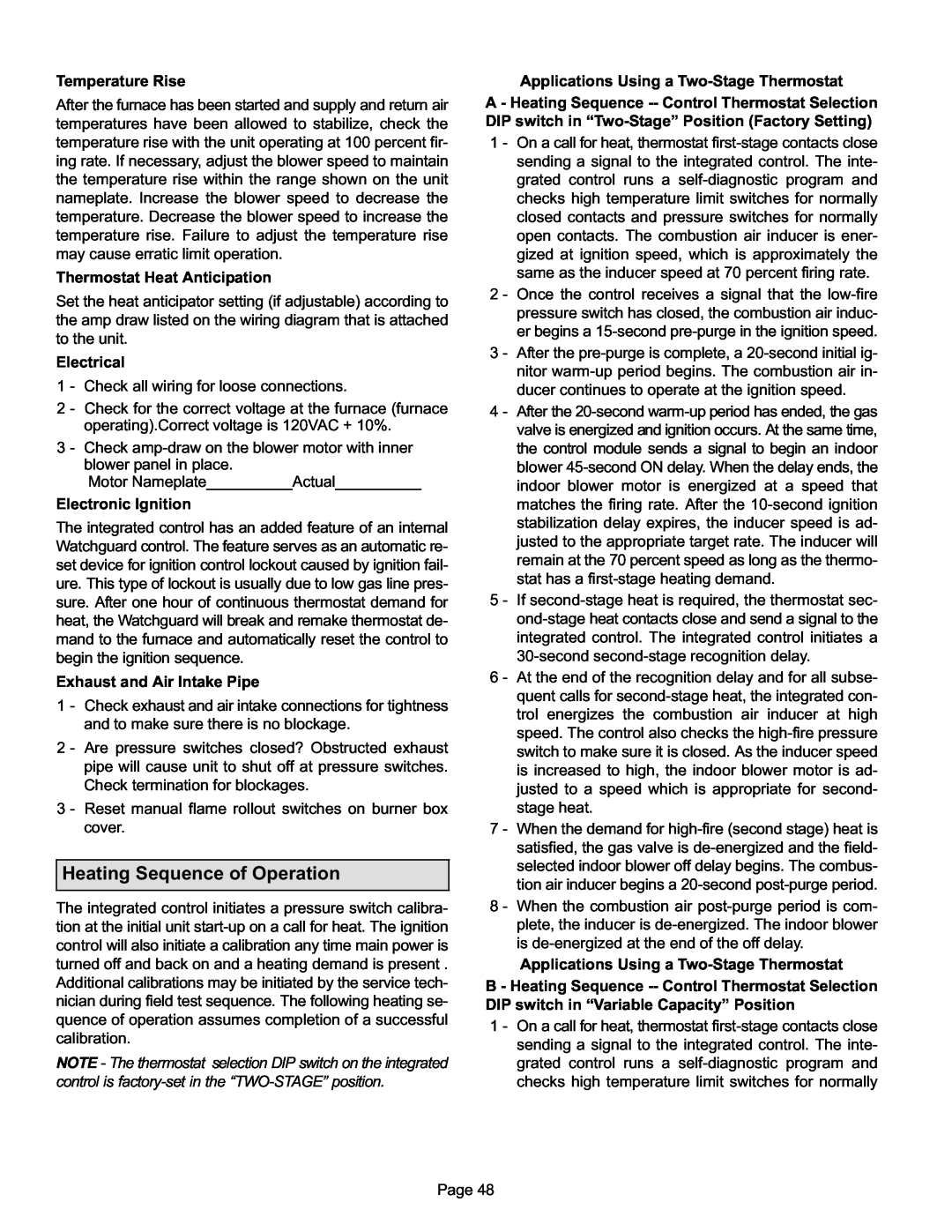Temperature Rise
After the furnace has been started and supply and return air temperatures have been allowed to stabilize, check the temperature rise with the unit operating at 100 percent fir- ing rate. If necessary, adjust the blower speed to maintain the temperature rise within the range shown on the unit nameplate. Increase the blower speed to decrease the temperature. Decrease the blower speed to increase the temperature rise. Failure to adjust the temperature rise may cause erratic limit operation.
Thermostat Heat Anticipation
Set the heat anticipator setting (if adjustable) according to the amp draw listed on the wiring diagram that is attached to the unit.
Electrical
1 − Check all wiring for loose connections.
2 − Check for the correct voltage at the furnace (furnace operating).Correct voltage is 120VAC + 10%.
3 − Check amp−draw on the blower motor with inner blower panel in place.
Motor Nameplate__________Actual__________
Electronic Ignition
The integrated control has an added feature of an internal Watchguard control. The feature serves as an automatic re- set device for ignition control lockout caused by ignition fail- ure. This type of lockout is usually due to low gas line pres- sure. After one hour of continuous thermostat demand for heat, the Watchguard will break and remake thermostat de- mand to the furnace and automatically reset the control to begin the ignition sequence.
Exhaust and Air Intake Pipe
1 − Check exhaust and air intake connections for tightness and to make sure there is no blockage.
2 − Are pressure switches closed? Obstructed exhaust pipe will cause unit to shut off at pressure switches. Check termination for blockages.
3 − Reset manual flame rollout switches on burner box cover.
Heating Sequence of Operation
The integrated control initiates a pressure switch calibra- tion at the initial unit start−up on a call for heat. The ignition control will also initiate a calibration any time main power is turned off and back on and a heating demand is present . Additional calibrations may be initiated by the service tech- nician during field test sequence. The following heating se- quence of operation assumes completion of a successful calibration.
NOTE − The thermostat selection DIP switch on the integrated control is factory−set in the AGE" position.
Applications Using a Two−Stage Thermostat
A − Heating Sequence −− Control Thermostat Selection DIP switch in wo−Stage" Position (Factory Setting)
1 − On a call for heat, thermostat first−stage contacts close sending a signal to the integrated control. The inte- grated control runs a
2 − Once the control receives a signal that the low−fire pressure switch has closed, the combustion air induc- er begins a 15−second pre−purge in the ignition speed.
3 − After the pre−purge is complete, a 20−second initial ig- nitor warm−up period begins. The combustion air in- ducer continues to operate at the ignition speed.
4 − After the 20−second warm−up period has ended, the gas valve is energized and ignition occurs. At the same time, the control module sends a signal to begin an indoor blower 45−second ON delay. When the delay ends, the indoor blower motor is energized at a speed that matches the firing rate. After the 10−second ignition stabilization delay expires, the inducer speed is ad- justed to the appropriate target rate. The inducer will remain at the 70 percent speed as long as the thermo- stat has a first−stage heating demand.
5 − If second−stage heat is required, the thermostat sec- ond−stage heat contacts close and send a signal to the integrated control. The integrated control initiates a 30−second second−stage recognition delay.
6 − At the end of the recognition delay and for all subse- quent calls for second−stage heat, the integrated con- trol energizes the combustion air inducer at high speed. The control also checks the high−fire pressure switch to make sure it is closed. As the inducer speed is increased to high, the indoor blower motor is ad- justed to a speed which is appropriate for second− stage heat.
7 − When the demand for high−fire (second stage) heat is satisfied, the gas valve is de−energized and the field− selected indoor blower off delay begins. The combus- tion air inducer begins a 20−second post−purge period.
8 − When the combustion air post−purge period is com- plete, the inducer is de−energized. The indoor blower is de−energized at the end of the off delay.
Applications Using a Two−Stage Thermostat
B − Heating Sequence −− Control Thermostat Selection DIP switch in ariable Capacity" Position
1 − On a call for heat, thermostat first−stage contacts close sending a signal to the integrated control. The inte- grated control runs a
Page 48
